Sources and Destinations of Oil Leakage through TPOCR Based on 2D-LIF Observation and Modeling Analysis
Abstract
:1. Introduction
2. Experimental Setup
3. Results
4. Discussion
4.1. Source and Mechanism of Up-Scraping
4.2. Dependency with Load and Speed
4.3. Asymmetrical Rail Profile
4.4. Asymmetrical Rail Flipped Installation
5. Conclusions
- In the up-strokes, the ring dynamics of the TPOCR can cause a negative twist of the upper rail, which reduces the oil flow rate at the leading edge. As a result, the upper rail with a symmetrical or a flipped asymmetrical profile can scrape up the oil film on the liner. The part of the scraped oil can be pushed into the OCR groove clearance and the rest is stored in the upper part of the rail OD.
- At the TDC. when the piston changes direction, the up-scraped oil can leak to both the third land and liner. More specifically, the oil inside groove can be squeezed out to both the third land and liner and the oil stored at the upper part of the rail OD is reattached to the liner. The oil leaked to the liner (Sources 1.2 and 2) is a major contributor to cause LOC and provide lubrication to the dry region at the same time. The interaction of these two oil sources on the liner with the top two rings will lead to wetting of the dry region as well as possible up- or/and down-scraping by the top ring. Consequently, the amount of these two oil sources is critical to both LOC and proper lubrication of the top ring groove and liner dry region, which will be studied in the future.
- Higher engine loads can experience more oil up-scraping. This is because during the expansions stroke, a raised third land pressure can push the TPOCR downwards to generate more negative twist to the upper rail while holding the lower rail with less positive twist, both resulting in more oil to pass the liner with higher load. Additionally, in the exhaust stroke, a higher load results in an increased negative twist on the upper rail and enhances the scraping by the upper rail.
- Using the asymmetrical rail profile by moving the parabola’s vertex lower than the center line can eliminate the oil up-scraping leakage. The flipped asymmetrical rail assembly’s increased oil leakage further proves the effectiveness of rail profile effect. However, the up-scraping is also an important source to provide lubrication to the dry region. A proper amount of oil leakage or supply should be achieved when considering the ring pack design.
Author Contributions
Funding
Data Availability Statement
Conflicts of Interest
References
- Richardson, D.E. Review of Power Cylinder Friction for Diesel Engines. J. Eng. Gas Turbines Power 2000, 122, 506–519. [Google Scholar] [CrossRef]
- Turnbull, R.; Dolatabadi, N.; Rahmani, R.; Rahnejat, H. An assessment of gas power leakage and frictional losses from the top compression ring of internal combustion engines. Tribol. Int. 2020, 142, 105991. [Google Scholar] [CrossRef]
- Ferrarese, A.; Marques, G.; Tomanik, E.; Bruno, R.; Vatavuk, J. Piston ring tribological challenges on the next generation of flex-fuel engines. SAE Int. J. Engines 2010, 3, 85–91. [Google Scholar] [CrossRef]
- Ulrich, A.; Czerwinski, J.; Mayer, A.; Mooney, J.J.; Kasper, M. Metal oxide particle emissions from diesel and petrol engines. In Proceedings of the SAE 2012 World Congress Exhibition, Detroit, MI, USA, 24–26 April 2012. [Google Scholar]
- Premnath, V.; Khalek, I.; Morgan, P.; Michlberger, A.; Sutton, M.; Vincent, P. Effect of lubricant oil on particle emissions from a gasoline direct injection light-duty vehicle. In Proceedings of the SAE International Powertrains, Fuels and Lubricants Meeting, Heidelberg, Germany, 17–19 September 2018. [Google Scholar]
- Leach, F.; Chapman, E.; Jetter, J.; Rubino, L.; Christensen, E.; John, P.; Fioroni, G.; McCormick, R. A review and perspective on particulate matter indices linking fuel composition to particulate emissions from gasoline engines. SAE Int. J. Fuels Lubr. 2021, 15, 3–28. [Google Scholar] [CrossRef]
- Schwanzer, P.; Schillinger, M.; Mieslinger, J.; Walter, S.; Hagen, G.; Märkl, S.; Haft, G.; Dietrich, M.; Moos, R.; Gaderer, M.; et al. A synthetic ash-loading method for gasoline particulate filters with active oil injection. SAE Int. J. Engines 2021, 14, 493–505. [Google Scholar] [CrossRef]
- Amann, M.; Alger, T. Lubricant Reactivity Effects on Gasoline Spark Ignition Engine Knock. SAE Int. J. Fuels Lubr. 2012, 5, 760–771. [Google Scholar] [CrossRef]
- Kawahara, N.; Tomita, E. Visualization of auto-ignition and pressure wave during knocking in a hydrogen spark-ignition engine. Int. J. Hydrogen Energy 2009, 34, 3156–3163. [Google Scholar] [CrossRef]
- Li, M.; Tian, T. Effect of Blowby on the Leakage of the Three-Piece Oil Control Ring and Subsequent Oil Transport in Upper Ring-Pack Regions in Internal Combustion Engines. Lubricants 2022, 10, 250. [Google Scholar] [CrossRef]
- Adelmann, J.; Becker, S.; Rabute, R.; Bruno, R. Optimized oil control ring design for emission reduction. In Zylinderlaufbahn, Kolben, Pleuel; VDI Reports; VDI Wissenforum GmbH: Düsseldorf, Germany, 2018; pp. 91–103. [Google Scholar]
- Froelund, K.; Menezes, L.; Johnson, H.; Rein, W. Real-Time Transient and Steady-State Measurement of Oil Consumption for Several Production SI-Engines. In Proceedings of the International Spring Fuels & Lubricants Meeting, Orlando, FL, USA, 7–9 May 2001. SAE Technical Paper 2001-01-1902. [Google Scholar] [CrossRef]
- Tian, T.; Wong, V.W.; Heywood, J.B. Modeling the Dynamics and Lubrication of Three Piece Oil Control Rings is Internal Combustion Engines. SAE Trans. 1998, 107, 1989–2006. [Google Scholar] [CrossRef]
- Li, Y. Study of the Factors That Influence the Lubrication of the Three-Piece Oil Control Ring. Master’s Thesis, Massachusetts Institute of Technology, Cambridge, MA, USA, 2017. [Google Scholar]
- Zhang, W. Modeling Internal Combustion Engine Three-Piece Oil Control Ring Coupling Reduced Order Oil Transport Based on Neural Network. Master’s Thesis, Massachusetts Institute of Technology, Cambridge, MA, USA, 2020. [Google Scholar]
- Mochizuki, K.; Sasaki, R.; Yazawa, M.; Iijima, N.; Usui, M. Prediction and Experimental Verification for Oil Transport Volume around Three-Piece Type Oil Control Ring Affecting Lubricating Oil Consumption. SAE Int. J. Adv. Curr. Pract. Mobil. 2023, 5, 595–609. [Google Scholar] [CrossRef]
- Ito, A.; Tsuchihashi, K.; Nakamura, M. A Study on the Mechanism of Engine Oil Consumption—Oil Upwards Transport via Piston Oil Ring Gap. In Proceedings of the SAE 2011 World Congress & Exhibition, Detroit, MI, USA, 12–14 April 2011. SAE Technical Paper 2011-01-1402. [Google Scholar] [CrossRef]
- Kikuhara, K.; Sekiya, H.; Ito, A.; Hayashi, H. A Study on Numerical Analysis Model of the Oil Film under the Oil Control Ring Considering the Generation Mechanism of Oil Pressure. Trans. Soc. Automot. Eng. Jpn. 2017, 48, 225–232. [Google Scholar] [CrossRef]
- Hasegawa, H.; Kikuhara, K.; Nishijima, S.; Suzuki, H.; Ito, A.; Sekiya, H.; Akamatsu, H. The Effect of the Position and Number of Oil Drain Hole on the Oil Pressure Generating under the Oil Ring with Relation to Oil Consumption. Trans. Soc. Automot. Eng. Jpn. 2017, 48, 59–64. [Google Scholar] [CrossRef]
- Kikuhara, K.; Sekiya, S.; Ito, A.; Hayashi, H. A Numerical Analysis on the Effect of Several Factors on the Oil Pressure under Oil Control Ring Which Relates to Oil Consumption. Trans. Soc. Automot. Eng. Jpn. 2018, 49, 282–289. [Google Scholar] [CrossRef]
- Li, M.; Zhong, X.; Ahling, S.; Tian, T. An Investigation of Oil Supply Mechanisms to the Top of the Liner in Internal Combustion Engines. In Proceedings of the 2023 JASE/SAE Powertrains, Energy and Lubricants International Meeting, Kyoto, Japan, 29 August–1 September 2023. SAE International JSAE 20239052/SAE 2023-32-0031. [Google Scholar]
- Ahling, S. Elements of Lubricant Transport Critical to Piston Skirt Lubrication and to Leakage into the Piston Ring Pack in Internal Combustion Engines. Ph.D. Thesis, Massachusetts Institute of Technology, Cambridge, MA, USA, 2021. [Google Scholar]
- Fang, T. Fluid Mechanics of Lubricant Transport in Non-Contact Regions in the Piston Ring Pack in Internal Combustion Engines. Ph.D. Thesis, Massachusetts Institute of Technology, Cambridge, MA, USA, 2019. [Google Scholar]
- Tian, T. Modeling the Performance of the Piston Ring-Pack in Internal Combustion engines. Ph.D. Thesis, Massachusetts Institute of Technology, Cambridge, MA, USA, 1997. [Google Scholar]
- Przesmitzki, S. Characterization of Oil Transport in the Power Cylinder of Internal Combustion Engines during Steady State and Transient Operation. Ph.D. Thesis, Massachusetts Institute of Technology, Cambridge, MA, USA, 2019. [Google Scholar]
- Fang, T. Computations and Modeling of Oil Transport between Piston Lands and Liner in Internal Combustion Engines. Master’s Thesis, Massachusetts Institute of Technology, Cambridge, MA, USA, 2014. [Google Scholar]
- Vokac, A. An Experimental Study of the Oil Evolution in Critical Piston Ring Pack Regions and the Effects of Piston and Ring Designs in an Internal Combustion Engine Utilizing Two-Dimensional Laser Induced Fluorescence and the Impact on Maritime Economics. Master’s Thesis, Massachusetts Institute of Technology, Cambridge, MA, USA, 2004. [Google Scholar]

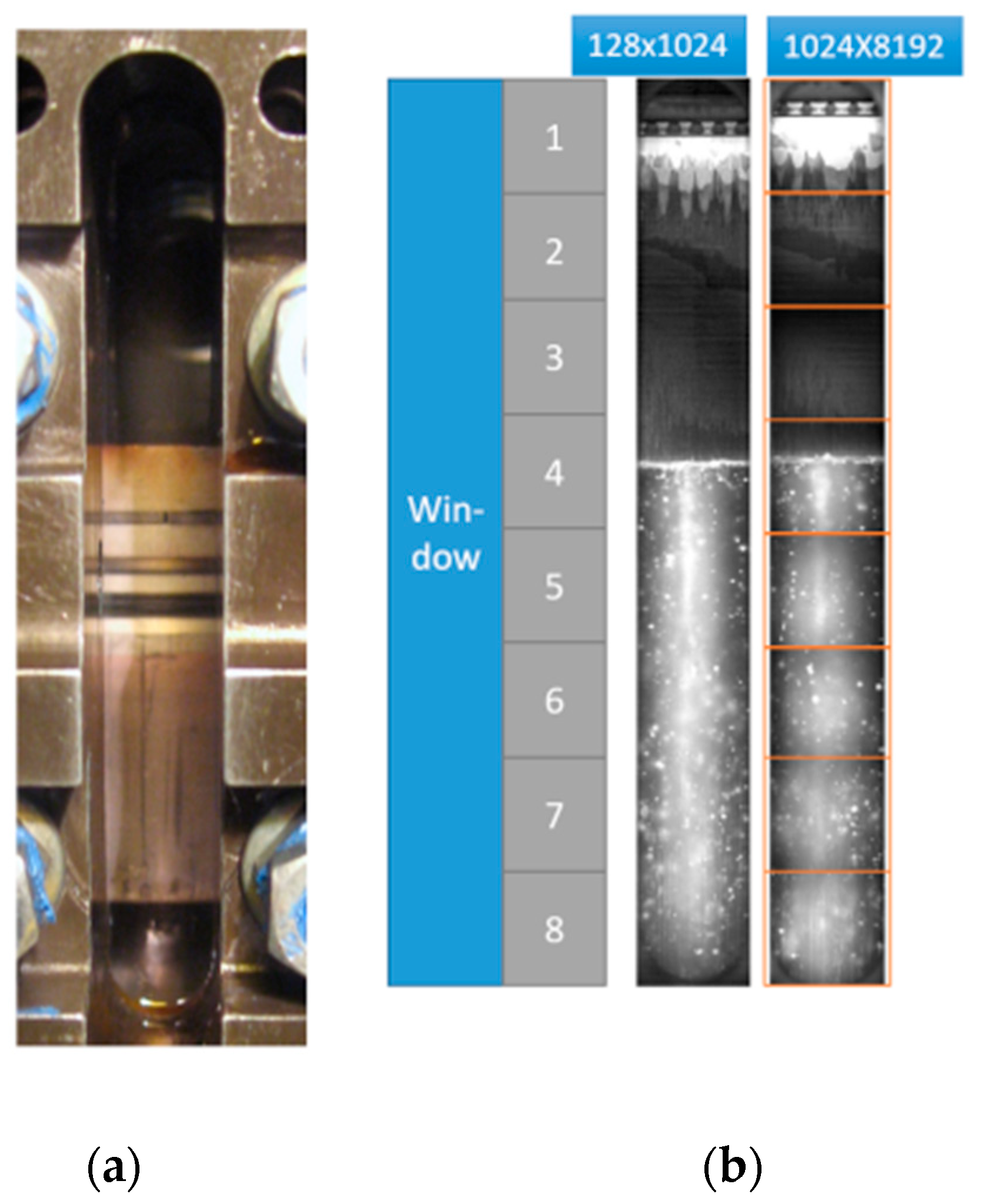
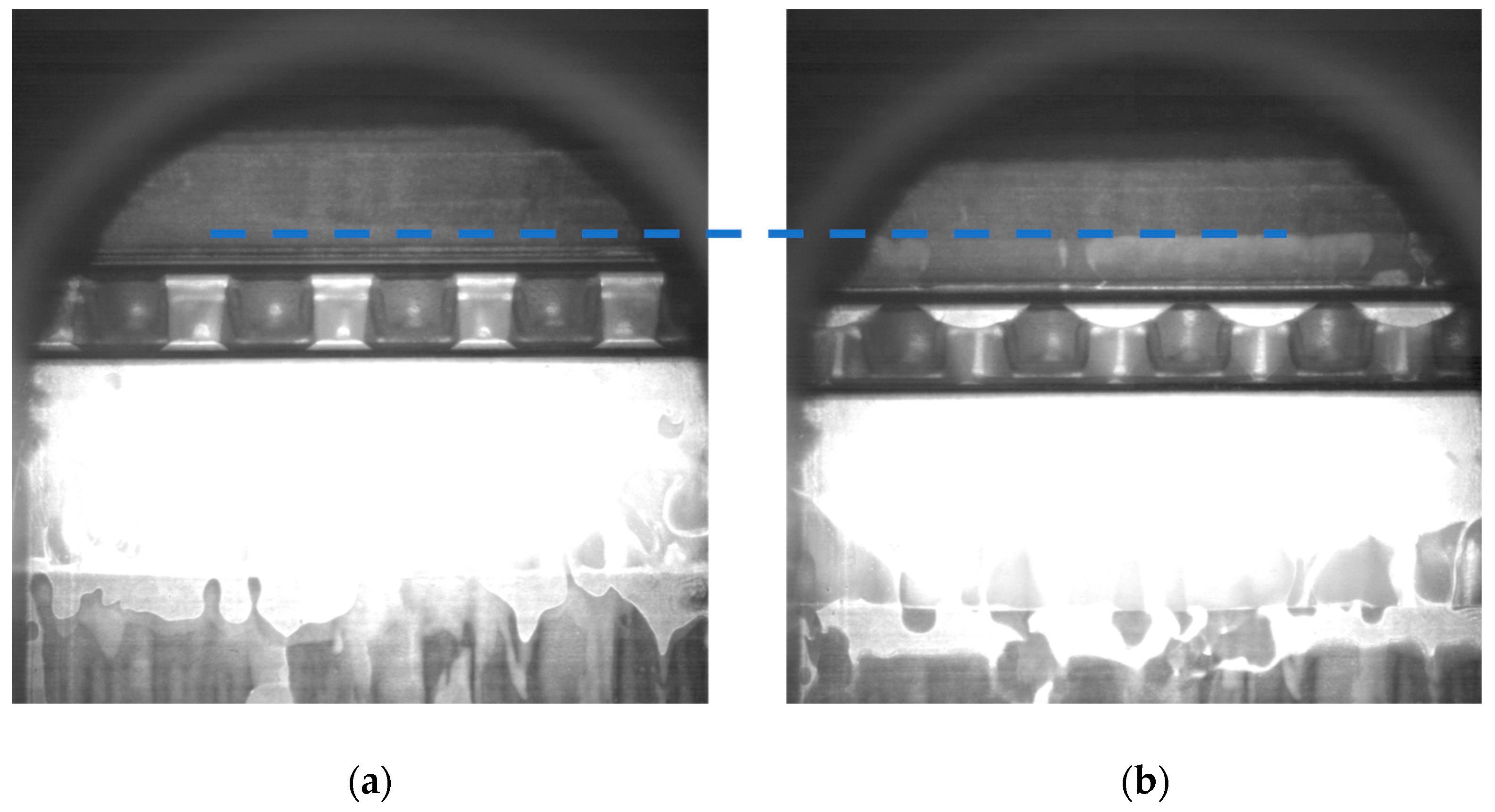

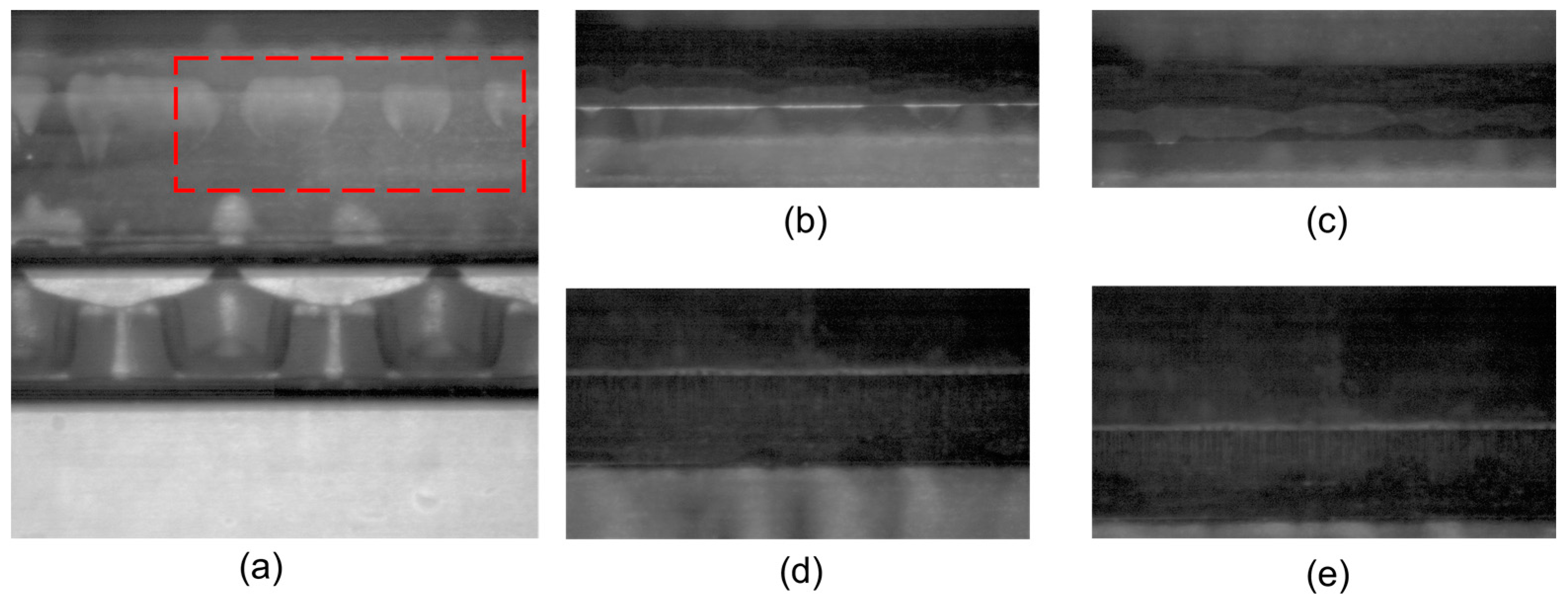


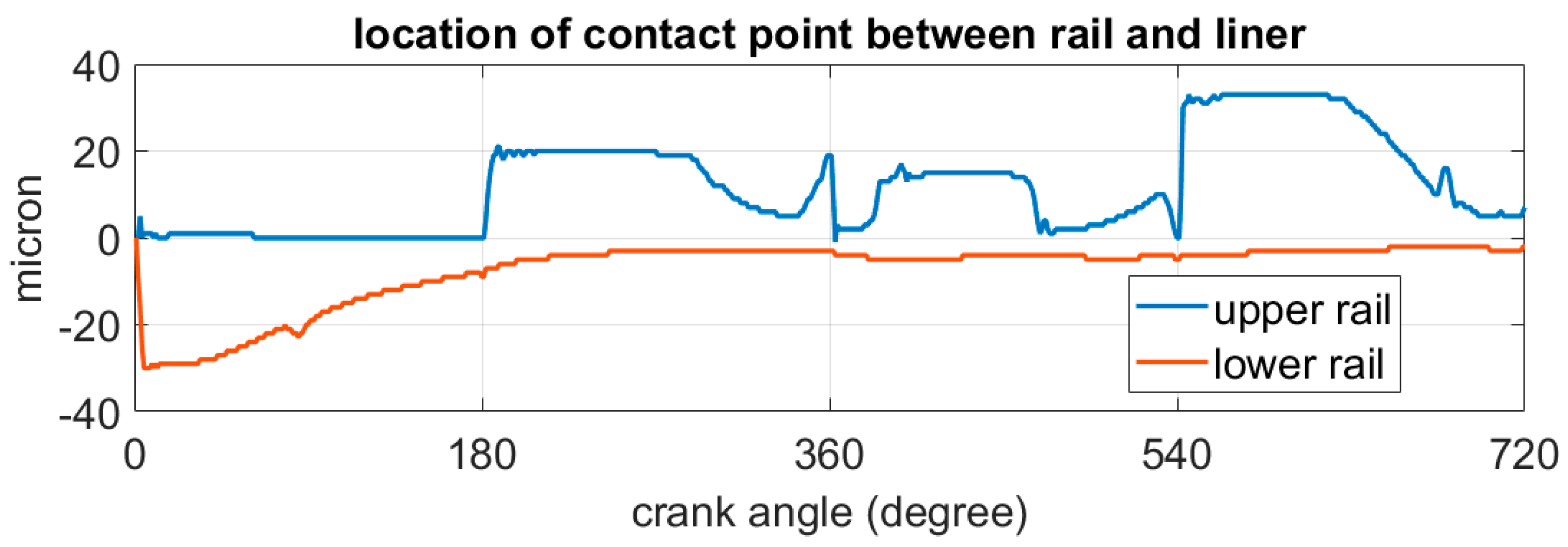
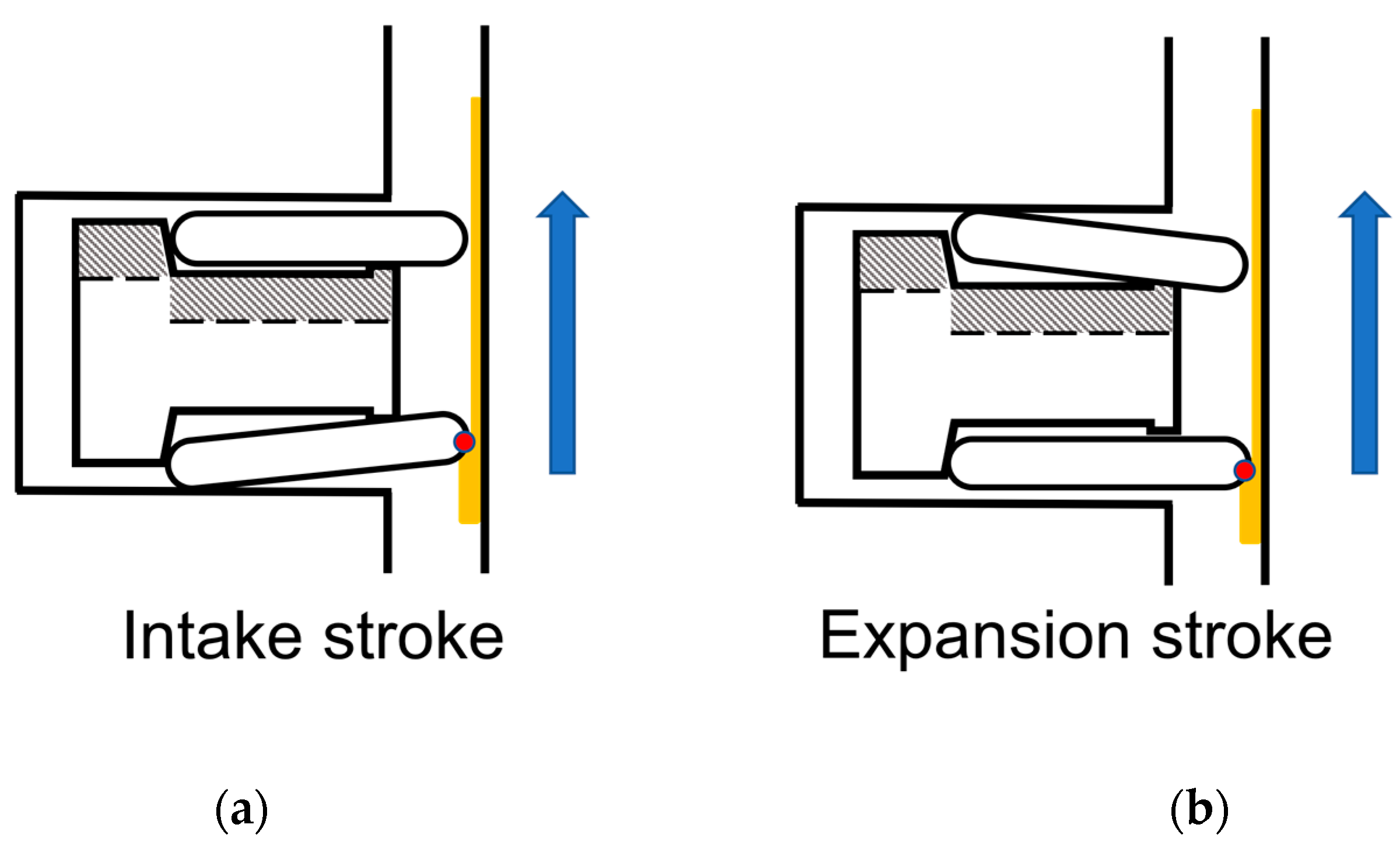

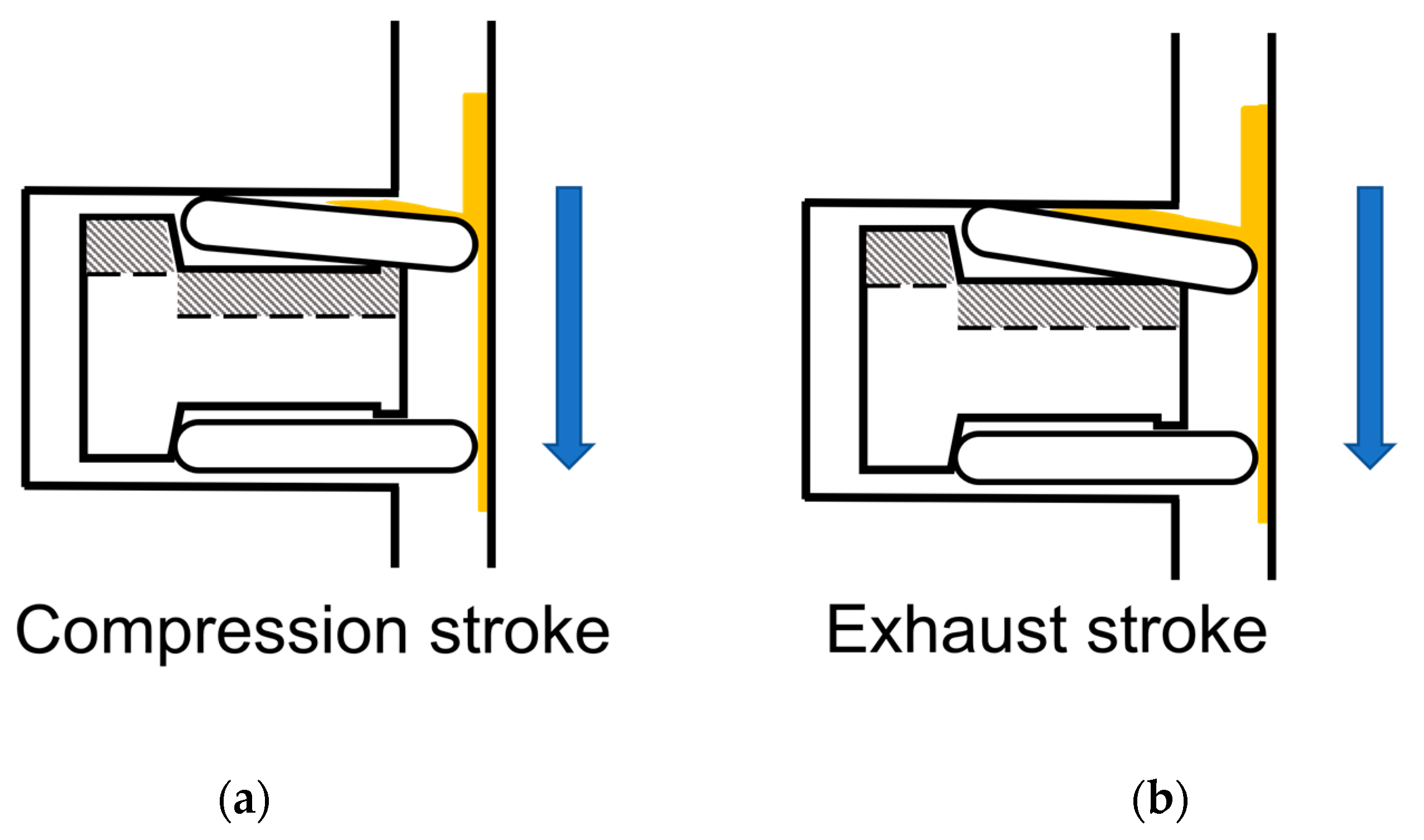








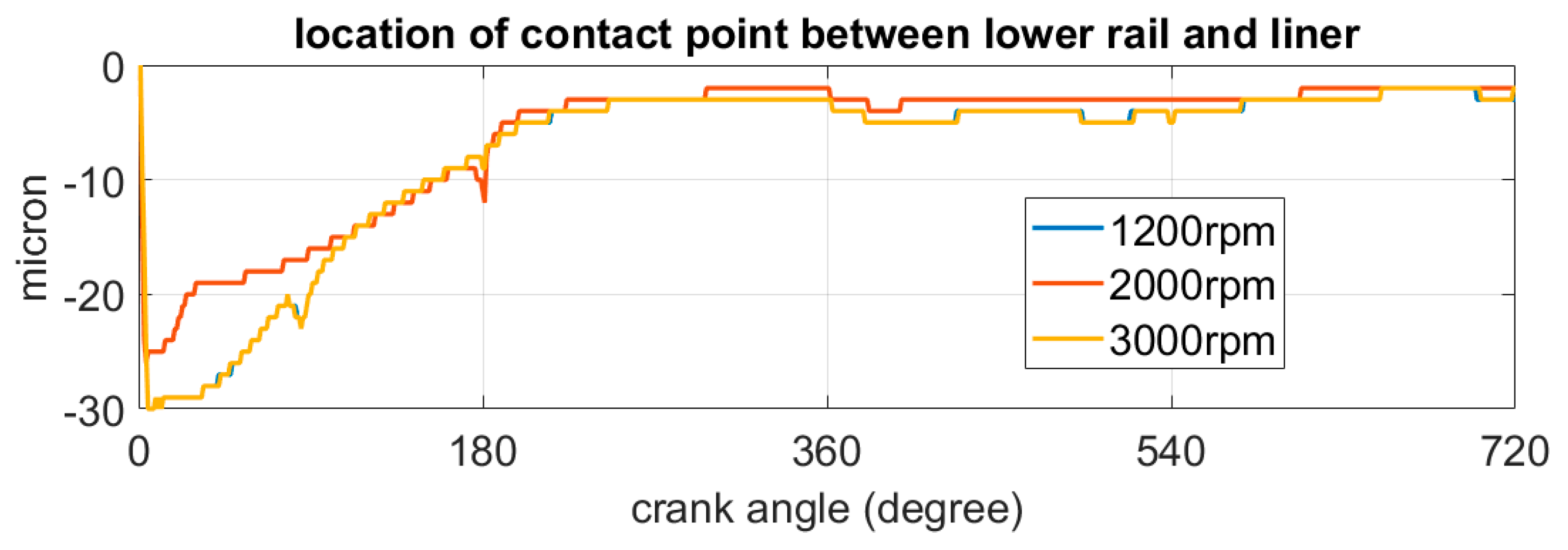
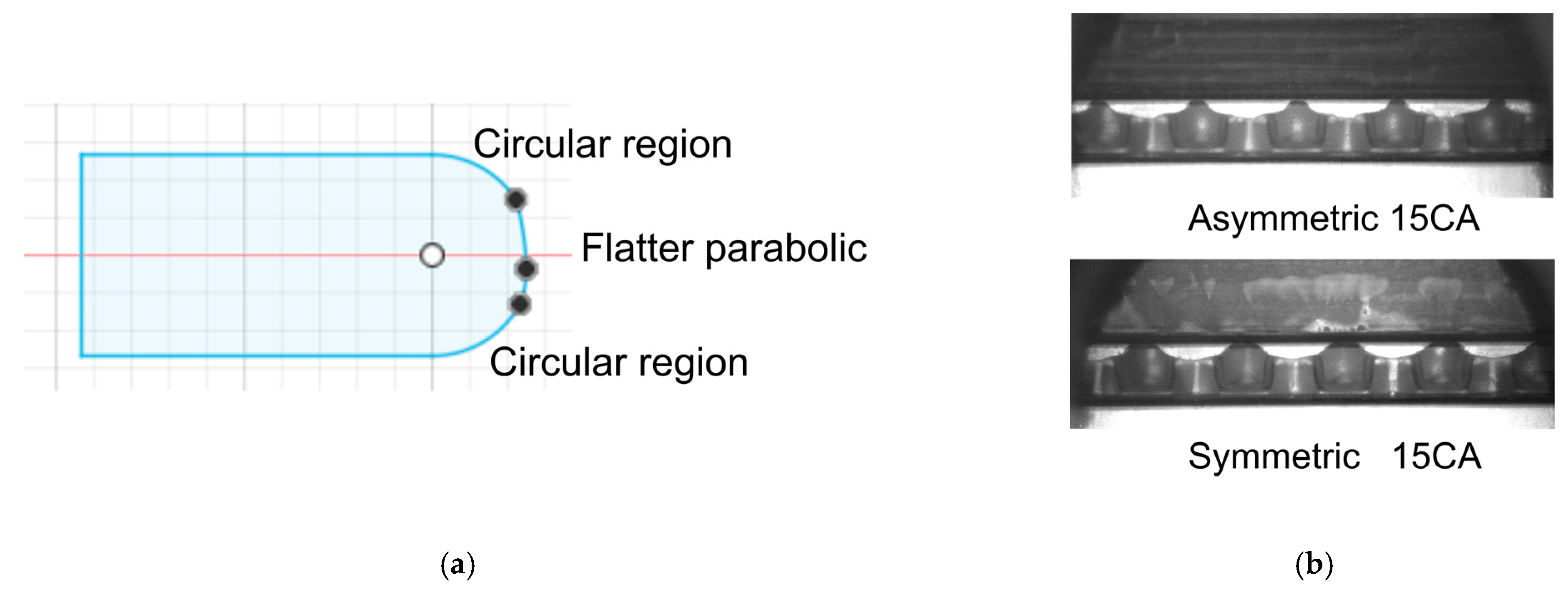

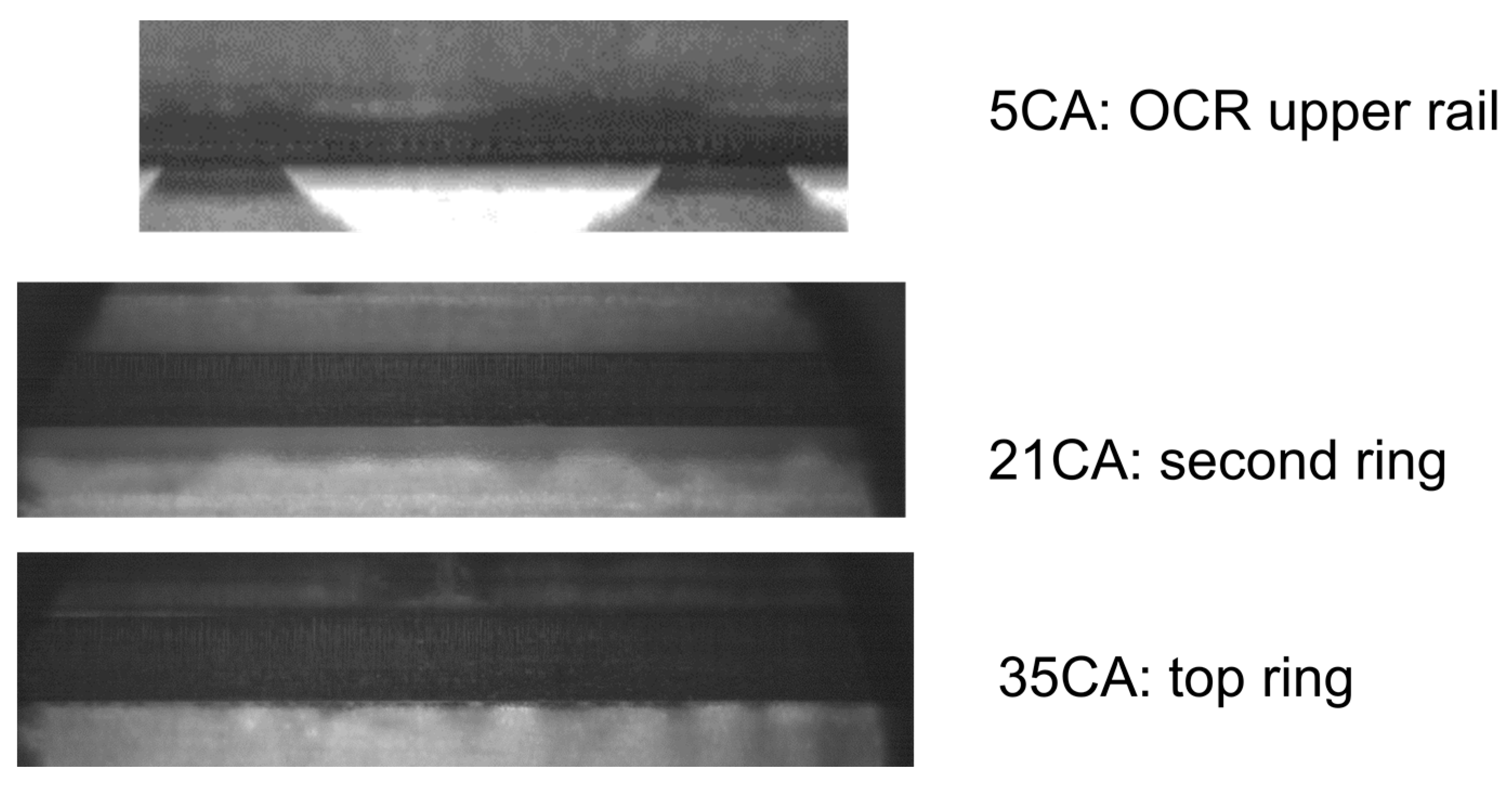
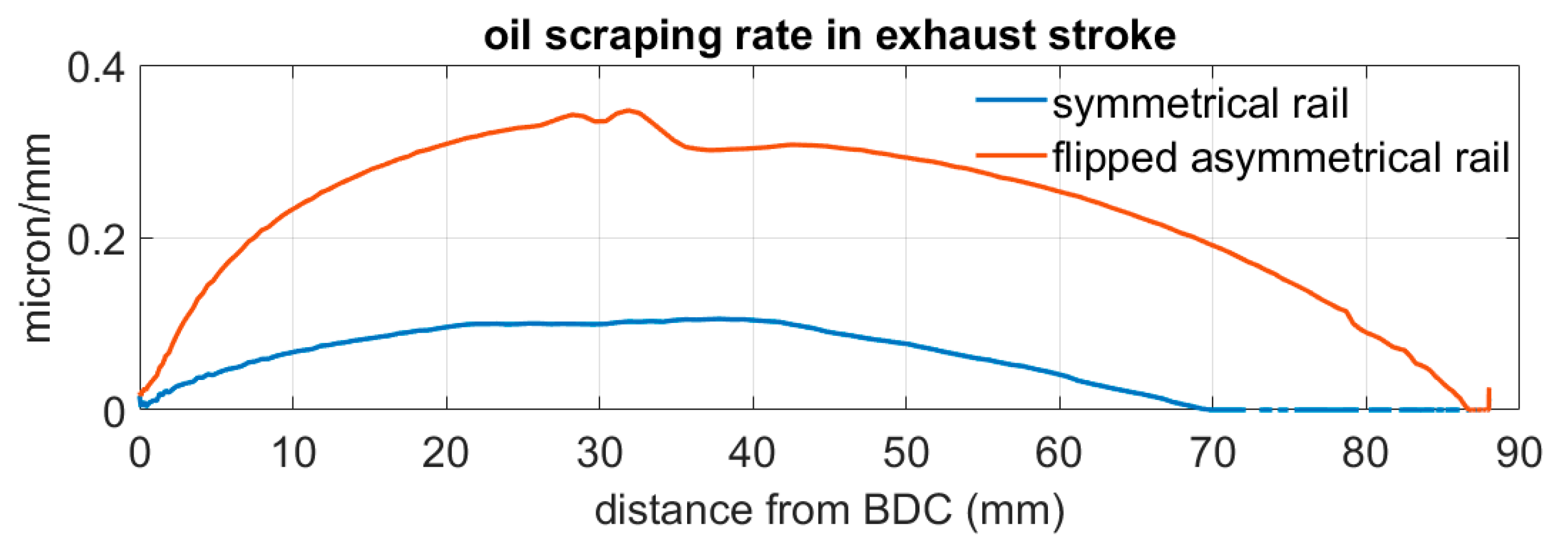
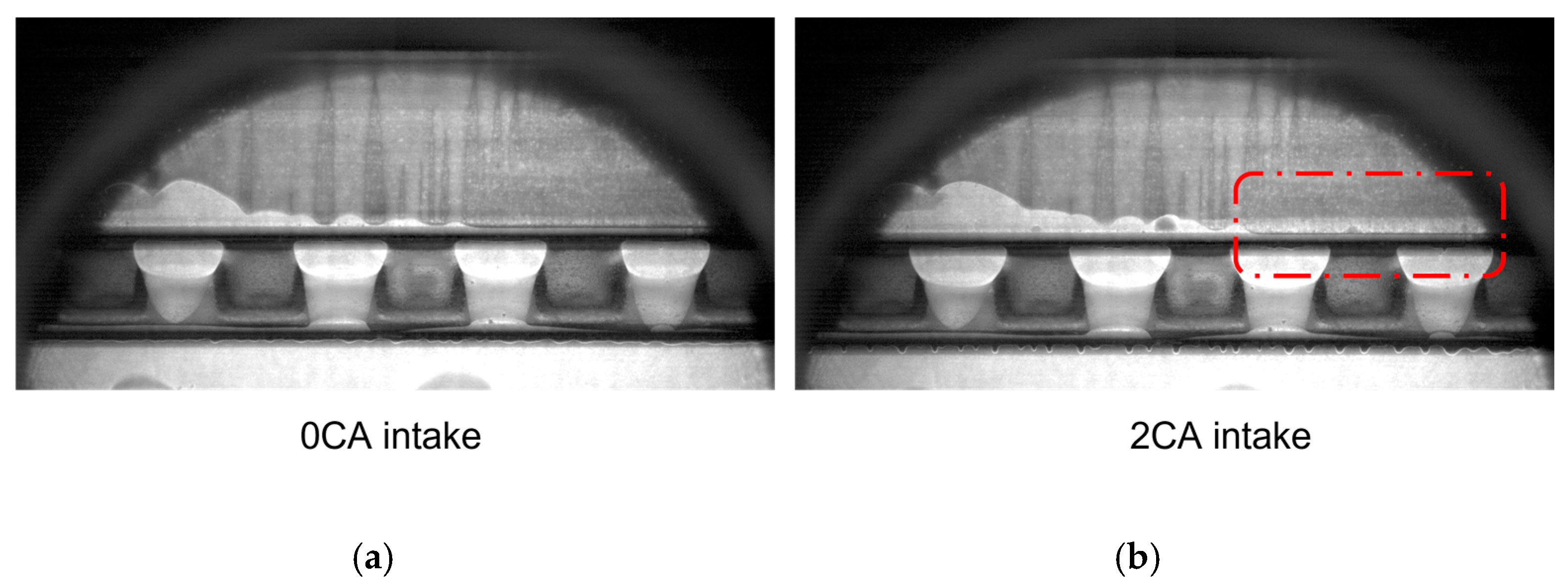
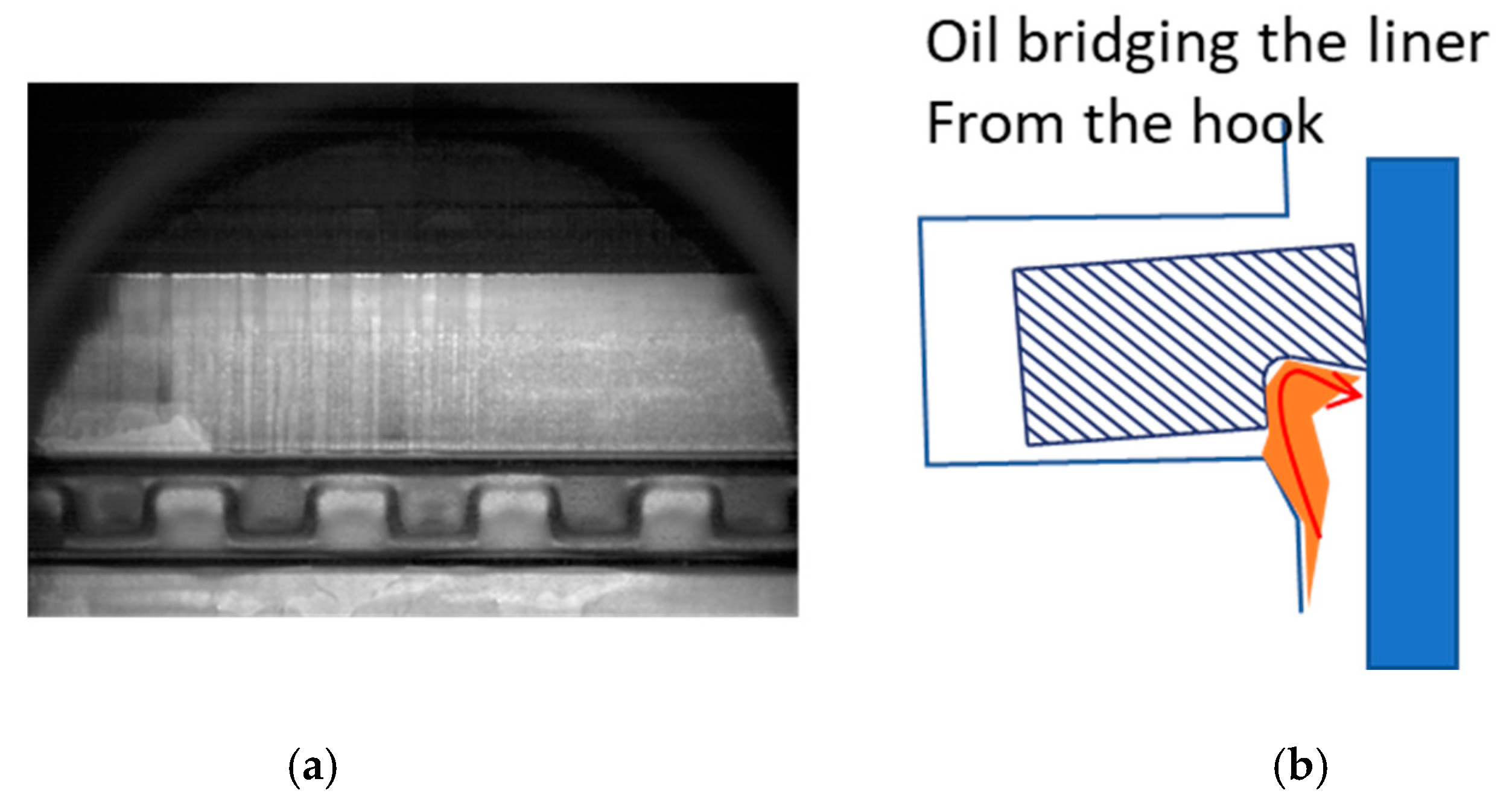

| Engine Characters | |
|---|---|
| Type | Spark Ignition 4 Valves |
| Bore | 86.6 mm |
| Stroke | 88.0 mm |
| Displacement | 0.511 L |
| Max specific power | 37.3 kW/L @ 5400 rpm |
| Max specific torque | 80 Nm/L @ 4200 rpm |
| Lubricant | SAE 0W20 |
| Top ring type | 1.2 mm thick barrel shape |
| Second ring type | 1.5 mm thick hook chamfer |
| Oil Control Ring type | 2 mm thick TPOCR |
Disclaimer/Publisher’s Note: The statements, opinions and data contained in all publications are solely those of the individual author(s) and contributor(s) and not of MDPI and/or the editor(s). MDPI and/or the editor(s) disclaim responsibility for any injury to people or property resulting from any ideas, methods, instructions or products referred to in the content. |
© 2023 by the authors. Licensee MDPI, Basel, Switzerland. This article is an open access article distributed under the terms and conditions of the Creative Commons Attribution (CC BY) license (https://creativecommons.org/licenses/by/4.0/).
Share and Cite
Li, M.; Tian, T. Sources and Destinations of Oil Leakage through TPOCR Based on 2D-LIF Observation and Modeling Analysis. Lubricants 2023, 11, 522. https://doi.org/10.3390/lubricants11120522
Li M, Tian T. Sources and Destinations of Oil Leakage through TPOCR Based on 2D-LIF Observation and Modeling Analysis. Lubricants. 2023; 11(12):522. https://doi.org/10.3390/lubricants11120522
Chicago/Turabian StyleLi, Mo, and Tian Tian. 2023. "Sources and Destinations of Oil Leakage through TPOCR Based on 2D-LIF Observation and Modeling Analysis" Lubricants 11, no. 12: 522. https://doi.org/10.3390/lubricants11120522
APA StyleLi, M., & Tian, T. (2023). Sources and Destinations of Oil Leakage through TPOCR Based on 2D-LIF Observation and Modeling Analysis. Lubricants, 11(12), 522. https://doi.org/10.3390/lubricants11120522





